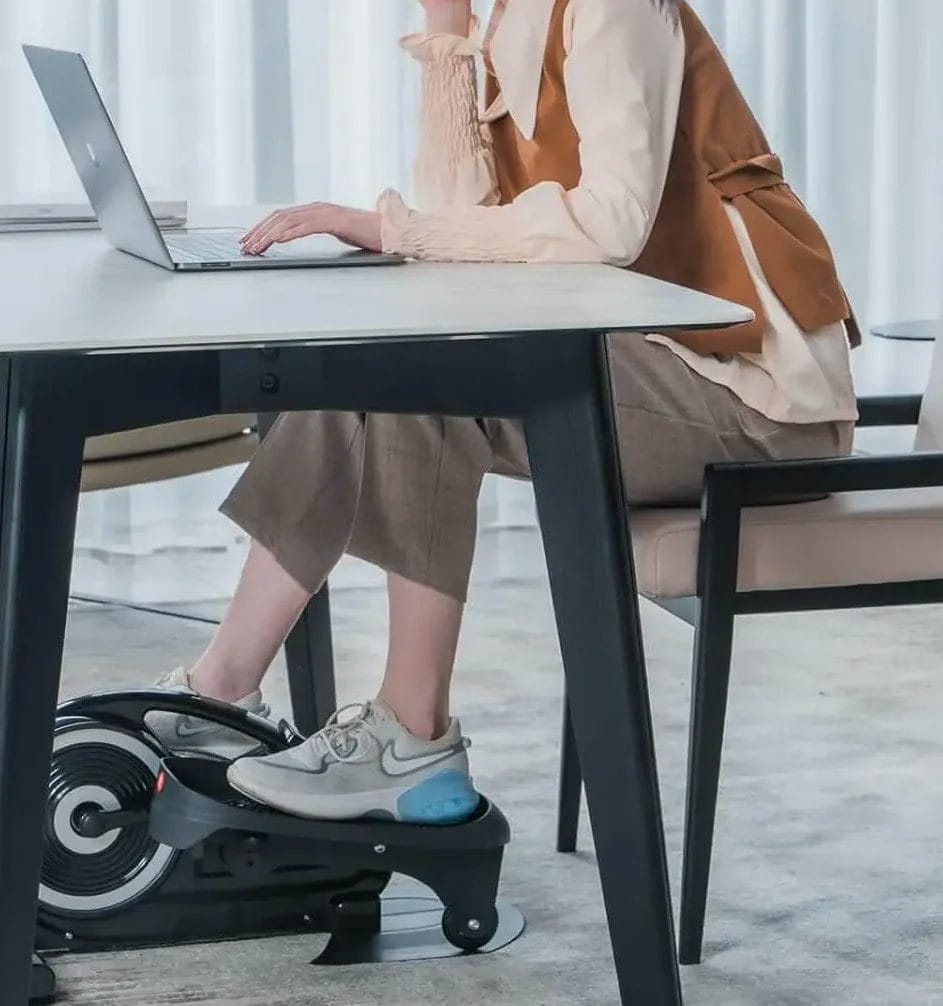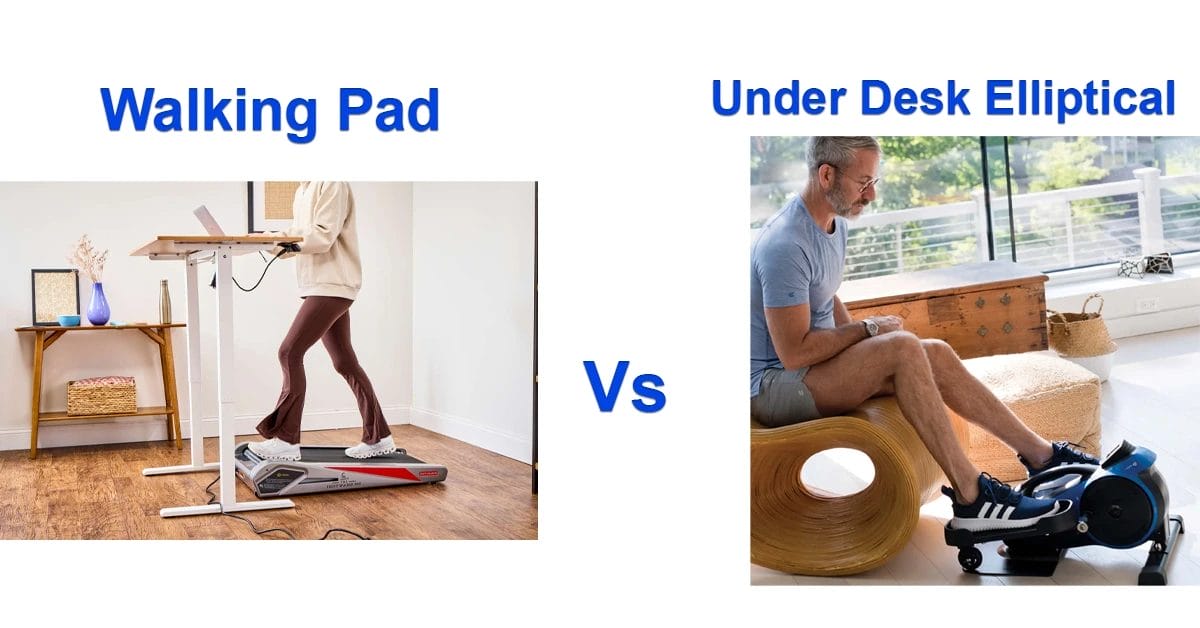If you work from home, you’ve probably Googled ways to stay active without sacrificing productivity. Two popular options dominate the conversation: walking pads and under-desk ellipticals.
But with so much conflicting advice online, how do you decide which is right? Let’s simplify the debate with a clear, focused comparison—no jargon, no fluff, just actionable insights.
Quick Comparison: Walking Pad Vs Under Desk Elliptical
Key differences between walking pads and under-desk ellipticals for buyers:
| Feature | Walking Pad | Under Desk Elliptical |
|---|---|---|
| Space Needed | ~1.5m length when active; foldable models save space | Shoebox-sized; fits under most desks |
| Noise Level | 50–60 dB (like a quiet dishwasher) | <40 dB (quieter than a desk fan) |
| Calorie Burn/Hour | ~200 calories (moderate pace) | ~150 calories (light resistance) |
| Needs practice in multitasking | $300–$500 | $90–$250 |
| Workout Focus | Full-body (legs, core, arms) | Lower-body (legs, glutes) |
| Best For | – Standing desk users – Weight loss goals | – Seated workers – Joint rehab/arthritis |
| Muscle Engagement | Moderate (natural walking motion) | Needs practice in multitasking |
| Storage | Requires vertical/horizontal space when folded | Fits under desks or in cupboards |
| Ease of Use | Light (circular pedaling) | Plug-and-play; pedal instantly |
| Ideal UK Home Type | Needs practice to multitasking | Studio flats or shared spaces (terraced houses) |
| NHS Activity Alignment | Yes (counts toward 150 weekly mins) | Yes (light activity for circulation) |
Key Takeaways for Buyers
- Walking pads suit those prioritizing calorie burn and standing desk compatibility.
- Under-desk ellipticals win for budget-friendly, quiet, and seated workouts.
What is a Walking Pad?

A Walking Pad is a compact, foldable treadmill designed for walking, not running. These portable devices are usually smaller and more lightweight than traditional treadmills, making them ideal for home use, especially in small spaces. Walking Pads typically offer adjustable speeds, allowing you to walk at a comfortable pace while working or relaxing.
Key Features of a Walking Pad:
- Compact and Foldable: Easy to store when not in use.
- Low-Noise Design: Quiet motors that won’t disturb your work or family members.
- Adjustable Speed: Choose from slow to moderate walking speeds to suit your fitness level.
- Ergonomically Designed: Often includes a simple control panel or remote for easy use.
Benefits of Using a Walking Pad:
- Improves Cardiovascular Health: Regular walking boosts heart health and stamina.
- Boosts Productivity: Walking while working can enhance focus and creativity.
- Convenience: Can be used while watching TV, working, or even reading.
- Burns Calories: Helps with weight management by increasing daily calorie expenditure.
What is an Under Desk Elliptical?

An Under Desk Elliptical is a smaller version of a traditional elliptical machine. Designed to fit under your desk, these machines allow you to engage in a full-body workout while sitting or standing at your workstation. They provide a low-impact cardiovascular exercise that targets both the upper and lower body, promoting overall fitness and health.
Key Features of an Under Desk Elliptical:
- Compact Design: Small enough to fit under most desks, making it a space-saver.
- Smooth Pedal Motion: Provides a fluid, elliptical motion that mimics walking or running without the joint strain.
- Adjustable Resistance: Customize the intensity of your workout by adjusting resistance levels.
- Silent Operation: Ideal for office environments, as they tend to operate quietly.
Benefits of Using an Under Desk Elliptical:
- Full-Body Workout: Engages both the legs and arms for a total-body exercise.
- Low-Impact Exercise: Protects joints, making it suitable for people with joint pain or those recovering from injuries.
- Increased Calorie Burn: Helps burn calories while you work, making it easier to stay active throughout the day.
- Improves Leg Strength: Great for toning legs, glutes, and core muscles.
Head-to-Head Comparison: Key Factors for Buyers
To cut through the noise, here’s how these devices stack up in five critical categories:
1. Space & Storage
- Walking Pad: Needs ~1.5m of floor space when active. Foldable models (e.g., WALKINGPAD WalkingPad) save space when stored.
- Under Desk Elliptical: Fits under most desks (the size of a laptop bag). Winner for studio flats or shared workspaces.
2. Noise Levels
- Walking Pad: Generates 50–60 decibels (similar to a quiet dishwasher). Avoid budget models—they can exceed 65 dB.
- Under Desk Elliptical: Runs at <40 dB (quieter than a desk fan). Best for open-plan homes or noise-sensitive environments.
3. Workout Effectiveness
- Walking Pad: Mimics natural walking, boosting heart rate and engaging multiple muscle groups. Ideal for weight loss or cardio goals.
- Under Desk Elliptical: Offers light resistance training. Better for improving circulation or rehabbing joints.
4. Budget
- Walking Pad: $300–$500 (e.g., WalkingPad R1 Pro or JLL T350).
- Under Desk Elliptical: $90–$250 (e.g., Cubii JR1 or Sportneer FlexCycle).
5. Ease of Use
- Walking Pad: Requires balancing typing with walking (takes practice).
- Under Desk Elliptical: Plug-and-play—start pedaling immediately.
Who Should Buy Which? A Quick Decision Guide
Choose a Walking Pad If You…
✅ Have a standing desk or high work surface.
✅ Want to burn calories while working.
✅ Prioritize full-body movement.
Choose an Under Desk Elliptical If You…
✅ Work seated and prefer subtle activity.
✅ Need a quiet, joint-friendly option.
✅ Have a tight budget or tiny workspace.
Under-desk Bike vs Elliptical vs Treadmill
When choosing between an under-desk bike, elliptical, or treadmill, consider your workspace and fitness goals:
- Under-desk bikes engage more leg muscles but require more knee clearance.
- Ellipticals offer smooth, low-impact movement while seated.
- Walking pads let you stay upright and burn more calories.
Is Elliptical Better Than Walking?
Both ellipticals and walking pads have benefits. Ellipticals are easier on the joints and suitable for seated use.
Walking pads mimic natural walking but may stress the knees over time. The best choice depends on your fitness needs.
Walking Pad (Treadmill) vs Mini Stepping Machine (Stair Stepper)
A walking pad provides continuous movement, great for burning calories steadily.
A mini-stepping machine (stair stepper) engages more muscles with an up-and-down motion, offering a more intense workout.
If you want a low-impact desk workout, a walking pad is better. If you prefer a higher-resistance workout, a stepper is a good choice.
Under Desk Walking Pad or Mini Stepper for WFH
For working from home (WFH), both options can work. A walking pad allows steady movement while working.
A mini stepper provides a more intense, muscle-engaging exercise in short bursts. Choose based on your activity preference and workspace size.
Final Verdict: Walking Pad or Under Desk Elliptical?
Both walking pads and under-desk ellipticals help you stay active while working from home. If you have space and enjoy walking, a walking pad is ideal. But if you need something compact, quiet, and easy on the joints, an under-desk elliptical is a better choice. Consider your home office setup and fitness goals to make the best decision.
FAQ. Walking Pad Vs Under Desk Elliptical
Can I type while using a walking pad?
Yes, but start at 1–2 km/h. Most users adapt within a week.
Do under-desk elliptical tone legs?
Lightly. For noticeable toning, pair with resistance bands or weights.
Which burns more calories?
Walking pads win (~200 vs ~150/hour).
Are these devices NHS-recommended?
While not NHS-endorsed, they align with guidelines to “move more” during sedentary days.


